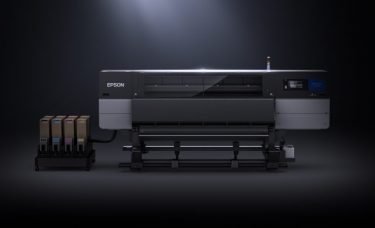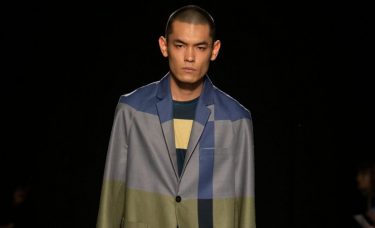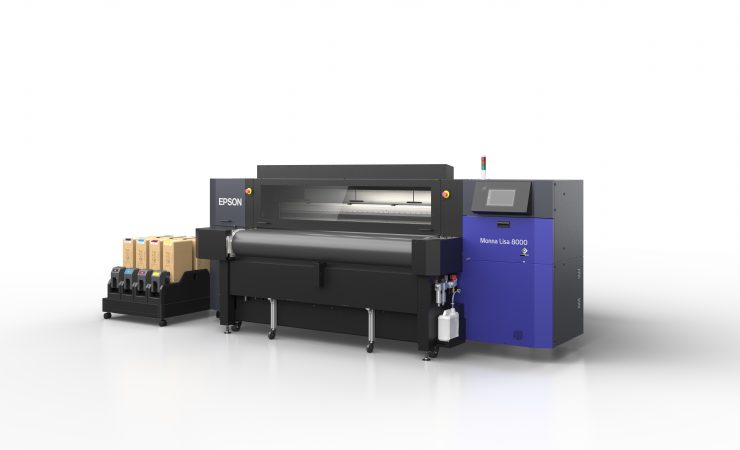It’s been an exciting year for textile printing. Despite the impact of the pandemic on commercial print, demand for digitally-printed textiles is on the rise and, even with so many key events cancelled, many exciting new products and technologies have been launched. The most recent is Epson’s ML-8000, the latest model in its Monna Lisa range. Charlie Kortens spoke with Epson’s sales development specialist Guy Martin to get a deeper understanding of this latest innovation and the company’s view of this burgeoning sector.
Epson describes its Monna Lisa range as ‘the heart of a high-tech total solution,’ saying that the ML-8000, which will be available in the UK from January 2021, introduces ‘a new standard in textile printing image quality.’ The system uses eight PrecisionCore printheads, prints at a resolution of up to 1200dpi and at a width of up to 180cm. The system operates at a typical print speed of 155sqm/hr but is capable of a maximum speed of 250sqm/hr.
‘The ML-800 is an entry-level machine in terms of the industrial space,’ Mr Martin explains. ‘There is a growing trend of textile printers looking to invest in wide-format machines but, given its ability to print at 155sqm/hr, the ML-800 is intended more to be an affordable option for industrial printers.’
What exactly does Mr Martin mean when he says ‘more affordable’? ‘I can’t give precise information about price,’ he says, ‘but you should be thinking below €200,000. It’s also important to remember that the ML-800 is intended to be a scalable solution. It’s especially important in the current environment to allow customers to invest in one system now whilst retaining the option to invest in more later.’
A new standard
If the machine does indeed provide a ‘new standard’ in textile printing, what exactly is it that makes it so special? Mr Martin immediately points to the experience of Robustelli, a developer and manufacturer of textile printers, and ink specialist For.Tex, Epson subsidiaries based on the shores of Lake Como, Italy.
‘Going forward, textiles printers are going to be looking at efficiency,’ Mr Martin explains. ‘They will be producing shorter runs with faster turnaround times. The combined expertise of Robustelli, For.Tex and Epson means that we have the ability to digitally print on demand products of the highest quality, using the most reliable machinery. We can position ourselves as the sole supplier of all the printheads, inks (before and after chemical treatment) and engineering support for the ML-800.
‘In addition, our image processing capabilities and the electronics behind delivering droplets are second to none. Epson’s global outreach also means that we are able to offer our solutions anywhere in the world.’
The competition and the customer
So, with such a strong product coming to market, who, if anyone, does Epson see as its competition in the marketplace? ‘We are one of very few companies able to say we manufacture our own hardware, inks and printheads,’ Mr Martin reiterates. ‘That puts us in a very unique position. Regarding the ML-800 specifically, its wide-format nature means that it isn’t exactly going head-to-head against most textile printers. Most other machines in the marketplace are single-pass and can’t match the quality or flexibility we can offer with multiple scanning heads.’
When it comes to the target market for the ML-800 and its other textiles machines Mr Martin acknowledges that Epson has to walk the fine line between targeting commercial printers that might be looking at moving into textiles, and those already working in the textiles sector that are considering branching out into digital print.
‘Obviously we’re targeting existing textile printers,’ Mr Martin continues. ‘Many presses are being sold to textile people who appreciate the benefits of digital printing, especially printing on demand, producing shorter runs and the ‘green’ benefits, including reducing waste going to landfill, less chemical usage and water wastage.
‘It should also be noted that one side-effect of the digitalisation of print is that printing itself is no longer the most skilled or complicated part of the printing process. That honour now goes to pre-treatment and finishing, especially in textiles. Here at Epson one of the key things we do is remove bottlenecks and similar difficulties. In the UK market experienced textile printers have has a resurgence and smoothing these issues out is essential.’
Mr Martin also notes that many of the trends he has just outlined, as well as the growing popularity of textile printing in general, have been apparent for some time but the effects of the Coronavirus pandemic seem to have accelerated them. He agrees that into that mix you can add concerns about the supply chain and production moving back to Western nations. Certainly it is an exciting time for textile printers.

Potential applications for the SC-F10000 include include fashion, sportswear, home furnishings, promotional goods and soft signage
Dye sublimation
This is further demonstrated not just by ML-8000, but by the SureColor SC-F10000 dye sublimation printer, another new system introduced by Epson, this one in early July.
The 1.9m printer, which operates at speeds of up to 255sqm/hr and uses the company’s Precision Core technology, is marketed as suitable for printing on fashion, sportswear, home furnishings, promotional goods and soft signage. Like the ML-8000, the SC-F10000 is designed to meet fast turnaround times whilst providing ‘reliable, consistent performance and high-quality output.’
As Mr Martin explains, the dye-sub SureColor prints onto polyester, whilst the Monna Lisa range is better suited for other textile types, most notably cotton. Nevertheless there is sure to be a good deal of overlap when it comes to companies investing in the different machines. ‘The only set-up costs when it comes to dye sublimation are the printer itself and then a calender,’ he says. ‘Once you’ve got those two things you can produce anything from small applications such as phone cases, through to sportswear and even high fashion. As with the textiles market in general, the growth rate in dye sublimation is huge.’
Inks
Of course one of the biggest differences between the two systems is the inks they use, and Epson’s ink offering is one of the areas that Mr Martin is most excited about. ‘Our Genesta inks have been developed with For.Tex specifically for textiles, fashion, décor and the like. They can be delivered by Epson printheads and in conjunction with Epson machinery, allowing us to provide the best results in the most reliable manner. Everything has been developed harmoniously within the same group.’
There are four main ink sets: acid, reactive, pigment and disperse. ‘Which set you use depends on the particular fabric you are printing on,’ Mr Martin adds. ‘Though each of them provides the very highest quality. Between them the four sets can print onto 90 – 95% of all textiles currently used in the industry.’
All of the Genesta inks boast environmental certification including Eco Passport certification and Global Organic Textile Standard recognition. Still, going forward the emphasis is going to be on pigment inks, which work with cotton and some other materials, as they need less treatment both pre- and post-press and therefore generate less chemical usage.
Sustainability
Naturally these sort of environmental considerations are of key interest to Epson. ‘Our main priority is reducing energy usage in the printing process,’ Mr Martin explains. ‘The fact that we manufacture all of our components ourselves allows us to eliminate unnecessary chemical usage and water wastage.’

Epson is supporting fashion students from the University of Westminster who are using printing in their designs.
He goes onto explain why so many textile printing companies are clustered around Lake Como in Lombardy. ‘Como is such a hub because of the purity of the water in the lake, specifically the lime levels. If you want an indication of how environmentally effective digital printing is compared to other methods of decorating textiles, just remember that 80 – 85% of the work done around Como is digital whereas the average across the globe is more like 7%.’
Excitement
Developments in the textiles markets are often said to be driven by Generation Z and other young people. These people are interested in personalisation, ethical production and the environment, all of which is good news for digital printing. Appropriately, one of the more interesting things Epson is doing is sponsoring students at the University of Westminster who are using digital printing methods to bring their designs to life.
‘We are privileged to be contributing to the education around textile printing,’ Mr Martin insists. ‘We want to continue to share our knowledge in an educational environment and help young people understand the possibilities we can offer. Of course we’re delighted if that puts our brand out there in front of a new generation.’
All very positive, but it still isn’t the thing that’s got Mr Martin most excited. ‘So much of our heritage comes from Como. Some of the biggest brands in the world manufacture there and our own group is now allowing us to offer the finest quality possible, backed up by huge experience, anywhere in the world. When you consider the global trends and what our group as a whole is now able to offer, the opportunities are huge.’
.





